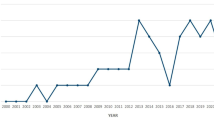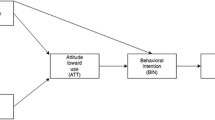Abstract
The continuous development of new platforms and environments for technology-enhanced learning emphasizes the increasing importance of research in educational technology acceptance (ETA). Responding to this need, the unified theory of acceptance and use of technology (UTAUT) proposes a major ETA model. However, the UTAUT has been so far validated only in restrained contexts. The ongoing internationalization of education calls for extending ETA research and the UTAUT across national and professional boundaries. Therefore, this study aims at cross-cultural validation of the UTAUT by examining a large sample (N = 4,589) of educational technology users from three European countries, Germany, Romania and Turkey. As a first conclusion, the UTAUT questionnaire displays adequate validity, reliability, and measurement equivalence across cultures, which further enables UTAUT-based comparisons of the cultural groups. Secondly, the effect of technology use intention on the actual use behavior proves to be extremely weak. Several possible explanations are proposed along with suggestions for future research. Thirdly, for the first time in ETA research the cultural sample diversity allows the verification of correlations between acceptance and culture. Thus, this study makes headway in the integration of culture (sensu Hofstede) in the UTAUT by suggesting effects of power distance, individualism, masculinity, uncertainty avoidance and long-term orientation on performance and effort expectancy, perceived social influence, computer anxiety, technology use intention and actual use behavior. Fourthly, for educational practice the presented results suggest several ways of anticipating and supporting ETA in multicultural user groups.




Similar content being viewed by others
References
Ajzen, I., & Fishbein, M. (2000). Attitudes and the attitude-behaviour relation: Reasoned and automatic processes. European Review of Social Psychology, 11, 1–33.
Bagozzi, R. P. (2007). The legacy of the technology acceptance model and a proposal for a paradigm shift. Journal of the Association for Information Systems, 4(3), 244–254.
Beaudry, A., & Pinsonneault, A. (2010). The other side of acceptance: Studying the direct and indirect effects of emotions on information technology use. MIS Quarterly, 34(4), 689–710.
Bentler, P. M., & Weeks, D. G. (1980). Linear structural equations with latent variables. Psychometrika, 45(3), 289–308.
Bollen, K. A. (1989). Structural equations with latent variables. New York: Wiley.
Brodbeck, F. C., & Frese, M. (2006). Societal culture and leadership in Germany. In J. S. Chhokar, F. C. Brodbeck, & R. J. House (Eds.), Culture and leadership around the world: The GLOBE book of in-depth studies of 25 societies (pp. 147–214). Mahwah: Lawrence Erlbaum.
Conti-Ramsden, G., Durkin, K., & Walker, A. (2010). Computer anxiety: A comparison of adolescents with and without a history of specific language impairment (SLI). Computers & Education, 54(1), 136–145.
Cronjé, J. C. (2011). Using Hofstede’s cultural dimensions to interpret cross-cultural blended teaching and learning. Computers & Education, 56, 596–603.
Dittler, U., Kahler, H., Kindt, M., & Schwarz, C. (Eds.). (2005). E-learning in Europe: Learning Europe. How have new media contributed to the development of higher education?. Münster: Waxmann.
Ess, C., & Sudweeks, F. (2006). Culture and computer-mediated communication: Toward new understandings. Journal of Computer-Mediated Communication, 11(2), 179–191.
Fischer, R., Vauclair, C. M., Fontaine, J. R. J., & Schwartz, S. H. (2010). Are individual-level and country-level value structures different? Testing Hofstede’s legacy with the Schwartz value survey. Journal of Cross-Cultural Psychology, 41(2), 135–151.
Göğüş, A., Nistor, N., & Lerche, T. (2012). Educational technology acceptance across cultures: A validation of the unified theory of acceptance and use of technology in the context of Turkish national culture. Turkish Online Journal of Educational Technology, 11(4), 394–408.
Grenness, T. (2012). Hofstede revisited: Is making the ecological fallacy when using Hofstede’s instrument on individual behavior really unavoidable? International Journal of Business and Management, 7(7), 75–84.
He, J. & van de Vijver, F. (2012). Bias and equivalence in cross-cultural research. Online readings in psychology and culture, Unit 2. Retrieved Nov 20 2012, from http://scholarworks.gvsu.edu/orpc/vol2/iss2/8.
Hofstede, G. (2001). Culture’s consequences: Comparing values, behaviors, institutions and organizations across nations. Thousand Oaks: Sage.
Hofstede, G. (2012). VSM 94. http://www.geerthofstede.nl/vsm-94. Accessed 15 Aug 2012.
Hofstede, G., & McCrae, R. R. (2004). Personality and culture revisited: Linking traits and dimensions of culture. Cross-Cultural Research, 38(1), 52–88.
Hu, L., & Bentler, P. M. (1999). Cutoff criteria for fit indexes in covariance structure analysis: Conventional criteria versus new alternatives. Structural Equation Modeling, 6(1), 1–55.
Im, I., Kim, Y., & Han, H. J. (2008). The effects of perceived risk and technology type on users’ acceptance of technologies. Information & Management, 45, 1–9.
Leidner, D. E., & Kayworth, T. (2006). A review of culture in information systems research: Toward a theory of information technology culture conflict. MIS Quarterly, 30(2), 357–399.
Lerche, T. & Kiel, E. (2013). Signifikanztestung der kulturellen dimensionen von Geert Hofstede (Statistical significance tests of Geert Hofstede’s cultural dimensions). Diagnostica (submitted).
Liu, S. (2012). The impact of forced use on customer adoption of self-service technologies. Computers in Human Behavior, 28(4), 1194–1201.
Livian, Y. F. (2011). Pour en finir avec Hofstede. Renouveler les recherches en management interculturel (pp. 26–27). Paris: Communication à la première conférence annuelle ATLAS/AFMI. mai 2011.
MacCallum, R. C., Browne, M. W., & Sugawara, H. M. (1996). Power analysis and determination of sample size for covariance structure modeling. Psychological Methods, 1(2), 130–149.
Messick, S. (1989). Meaning and values in test validation: The science and ethics of assessment. Educational Researcher, 18(2), 5–11.
Nistor, N., Lerche, T., Weinberger, A., Ceobanu, C. & Heymann, J. O. (2013). Towards the integration of culture in the unified theory of acceptance and use of technology. British Journal of Educational Technology. doi:10.1111/j.1467-8535.2012.01383.x.
Nistor, N., Schworm, S., & Werner, M. (2012). Online help-seeking in communities of practice: Modeling the acceptance of conceptual artifacts. Computers & Education, 59(2), 774–784.
Özdemir, S., & Kılıc, E. (2007). Integrating information and communication technologies in the Turkish primary school system. British Journal of Educational Technology, 38(5), 907–916.
Parola, A., & Ranieri, M. (2010). Media education in action. A research study in six European countries. Firenze: University Press.
Peterson, M. (2007). The heritage of CCM research: implications for the Hofstede chair. International Journal of CCM, 7(3), 359–377.
Podsakoff, P. M., MacKenzie, S. B., & Podsakoff, N. P. (2012). Sources of method bias in social science research and recommendations on how to control it. Annual Review of Psychology, 63, 539–569.
Pynoo, B., Tondeur, J., Braak, J., Duyck, W., Sijnave, B., & Duyck, P. (2012). Teachers’ acceptance and use of an educational portal. Computers & Education, 58, 1307–1308.
Schein, E. H. (2004). Organizational culture and leadership. San Francisco: John Wiley.
Šumak, B., Heričko, M., & Pušnik, M. (2011). A meta-analysis of e-learning technology acceptance: The role of user types and e-learning technology types. Computers in Human Behavior, 27(6), 2067–2077.
Triandis, H. C. (1972). The analysis of subjective culture. New York: Wiley.
Veltri, N. & Elgarah, W. (2009). The role of national culture in social networking adoption. In C. F. Rogers & Y. C. Chen (Eds.), Proceedings of the 12th Annual Conference of the Southern Association for Information Systems (pp. 169–174). Statesboro: Georgia Southern University. http://sais.aisnet.org/2009/proceedings/ SAIS%202009.pdf/Veltri,Elgarah.pdf. Accessed 15 Aug 2012).
Venkatesh, V., Morris, M. G., Davis, G. B., & Davis, F. D. (2003). User acceptance of information technology: Toward a unified view. MIS Quarterly, 27(3), 425–478.
Venkatesh, V., Thong, J. Y. L., & Xu, X. (2012). Consumer acceptance and use of information technology: Extending the unified theory of acceptance and use of technology. MIS Quarterly, 36(1), 157–178.
Venkatesh, V., & Zhang, X. (2010). The unified theory of acceptance and use of technology: U.S. versus China. Journal of Global Information Technology Management, 13(1), 5–27.
Wang, P. (2010). Chasing the hottest IT: Effects of information technology fashion on organisations. MIS Quarterly, 34(1), 63–85.
Zakour, A. B. (2007). Information technology acceptance across cultures. In W. K. Law (Ed.), Information resources management: Global challenges (pp. 25–53). Hershey: Idea.
Acknowledgments
The authors would like to thank the students of Dr. Aytaç Göğüş from the Project 102 course during spring and fall 2011 for their help with data collection in Turkey; to Astrid Arauner, Laura Bărgăoanu, Tina Busche, Ciprian Ceobanu, Virgil Dan, Maria Dragotă, Eliza Dulamă, Emese Istvánffy, Dan Mihăilă, Lorena Mureşan and Maximilian Wagner for their contributions to data collection in Germany and Romania; and to the anonymous reviewers for their constructive and helpful comments.
Author information
Authors and Affiliations
Corresponding author
Rights and permissions
About this article
Cite this article
Nistor, N., Göğüş, A. & Lerche, T. Educational technology acceptance across national and professional cultures: a European study. Education Tech Research Dev 61, 733–749 (2013). https://doi.org/10.1007/s11423-013-9292-7
Published:
Issue Date:
DOI: https://doi.org/10.1007/s11423-013-9292-7




